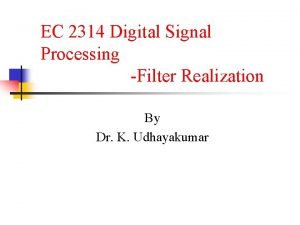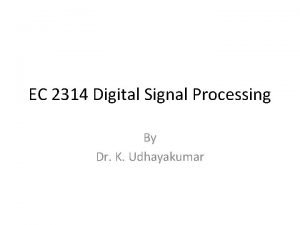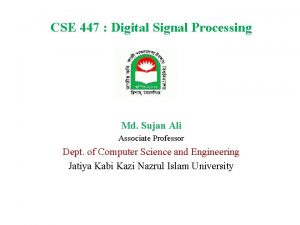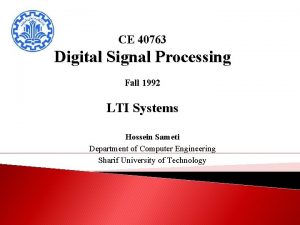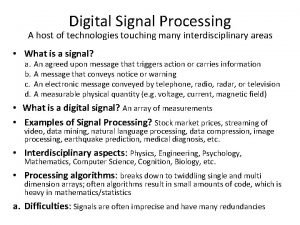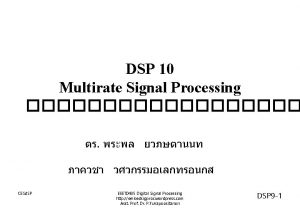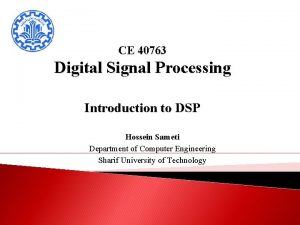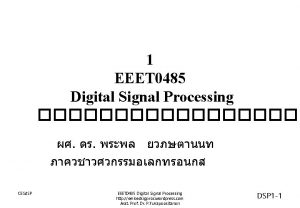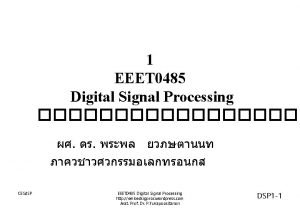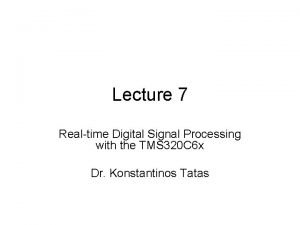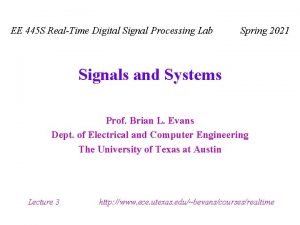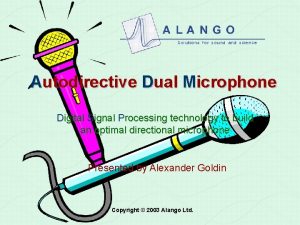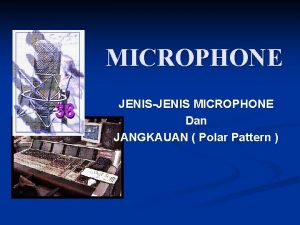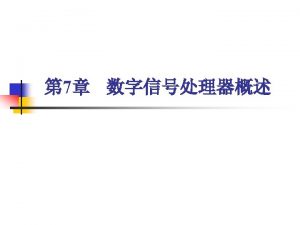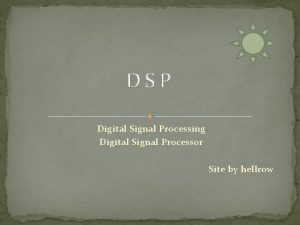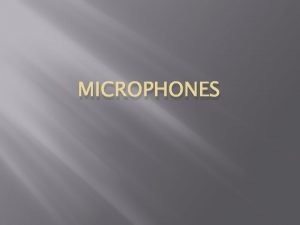Autodirective Dual Microphone Digital Signal Processing technology to












- Slides: 12

Autodirective Dual Microphone Digital Signal Processing technology to build an optimal directional microphone Presented by Alexander Goldin Copyright © 2003 Alango Ltd.

Null Hyper-cardioid = Null Bi-directional (figure eight) Distance factor = 1. 9 Distance factor = 2. 0 Omnidirectional Null Super-cardioid Bi-directional (d. B plot) Distance factor = 1. 7 Common microphone types Null Cardioid 2

The Optimal Directivity Microphone Ability: automatically change the directivity pattern Objective: the best signal-to-noise ratio in varying acoustic conditions. Challenge: Fast adaptation with minimal distortion 3

Electronic Directional Microphone Delay EQ( , ) Normalized polar pattern as a function of (fixed frequency) 4

Autodirective Dual Microphone Delay EQ( , ) Dual microphone with variable polar pattern DSP based dual microphone 1. Divide both channels on subbands 2. Create an optimal microphone in every frequency band 3. Equalize every band 4. Combine from bands Autodirective Dual Microphone schematic 5

Adaptive Directivity Block ADB functionality: 1. Estimate sensor difference (gain “s”) 2. Define the optimal delay “ “ ” 3. Compute equalization gain “g” according to and ; Autodirective Dual Microphone schematic Adaptive Directivity Block schematic 6

Measured ADM polar pattern 7

ADM and other Alango technologies Additional Processing Ø Noise Suppression Ø Multiband Dynamic Range Reduction Ø Automatic Gain Control Other Alango technologies use the same subband decomposition scheme. Integration of technologies is easy without extra MIPS, Memory or time delay required. 8

ADM: summary of virtues ü An optimal, adaptive polar pattern with a very low adaptation time (around 5 ms) ü Far and close talk operations ü Low latency (<5 ms) ü No proximity effect ü Low sensitivity to wind and other turbulences ü Easy integration with other Alango technologies ü Low demands to constituting SPL sensors ü Easy integration into mobile and other devices 9

ADM applications Mic. 2 Mic. 1 Cellular Phones ADM is perfect for cellular phones. ADM technology significantly improves signal quality for both speakerphone (far-talk) and handset (close-talk) phone usage. Hearing aids ADM works very well in hearing aids. It provides high attenuation of ambient noise and other off-axis sounds. Mic. 1 Mic. 2 Reporter’s microphone ADM excellent and adaptive directivity combined with its immunity to wind noise makes it ideal technology for such application. Conference microphone ADM excellent directivity, lack of proximity effect and low sensitivity to popping and puffing sounds eliminates most of conference microphone problems. Hands-free car kits ADM high directivity, immunity to wind noise and low components cost provides unparallel benefits 10

ADM in cellular phones In the close-talk (handset ) mode, ADM creates “Bubble Of Sensitivity” (BOS) muting outside sounds In the far-talk (speakerphone ) mode, ADM creates “Beam Of Sensitivity” (BOS) attenuating outside sounds Outside BOS (regular mic) Inside BOS (ADM) Beam Of Sensitivity (BOS) Inside BOS (ADM) AD M Microphones 11

Alango contact information www. alango. com Headquarters: Edgar 1, Tirat-Carmel 39100, Israel Telephone: +972 4 8580743 Fax: +972 4 8580621 e-mail: sound. info@alango. com 12

